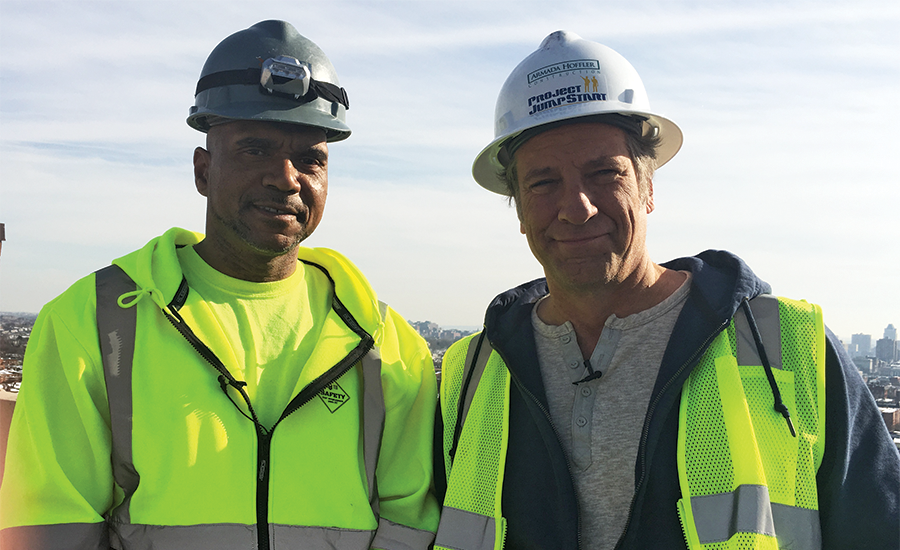Construction Workers' Voices
Coming Full Circle Back to Electrical Construction
A former addict recovers and returns to the building trades

Tyrone Ferrens (left) stands alongside Mike Rowe, host of CNN’s “Dirty Jobs,” on the roof of a federal courthouse building.
PHOTO COURTESY OF TYRONE FERRENS
For some, construction is a vocation. For Tyrone Ferrens, a journeyman electrician working in the industry has literally been a lifeline. Originally from the Bronx, Ferrens began his construction career through the Navy, when he enrolled in a Seabees electrician training program in 1986. Unfortunately, at that time, he lacked the discipline to succeed, he says. “I don’t think I was ready. I wasn’t mature enough for it.”
After being discharged from the Navy, Ferrens fell into dark times, and became addicted to drugs, a plight he struggled with for 16 years. But he reached a point where he realized he needed to change, and he went back to his roots—electrical construction work.
In 2011 he found a job as an apprentice with Hersch Electric in Baltimore, and ultimately enrolled in the Associated Builders and Contractors’ apprenticeship program. “It had always been something I wanted to do; it just took a long time for me to get back to doing it.”

“In construction, you're always learning something new.”
–Tyrone Ferrens
(48),
Electrician
Baltimore
Tessa Electric
He is now employed by Tessa Electric as a journeyman, and loves it. He says his company is on the “cutting edge” of technology and has great benefits. He has worked on projects all over the Baltimore area, he says, from traffic signals to stadium lighting projects to airplane warning lights atop tall buildings. One of his most interesting jobs was a laboratory project at the University of Maryland, which required specialized materials that were challenge to work with. Additionally, the design size and scope of the project “was very complicated,” he says.
Ferrens says he likes the variety of tasks that he performs on different jobs. “You’re always learning something new,” he says. He speaks enthusiastically about learning how to use a new 3D-scanner on his current jobsite on a federal courthouse project in Baltimore.
He notes, however, that the variety itself can be a double-edged sword. There is a level of uncertainty about what or where his next job will be. Although he feels secure in his trade and prospects for future work, he doesn’t always know what he will be earning on his next job, or whether the job will be conveniently located. On one recent assignment, he had to drive two hours to and from the site, followed by his apprenticeship classes, he says.
He also is on different pay scales, depending on whether the job is a prevailing wage job or not. He can go from earning more than $60 an hour on a prevailing wage project to $23/hour, he says. “That unknown can be a challenge,” he says.
Nevertheless, he has done well. He completed the apprenticeship program this May, and achieved journeyman status. He has been able to send his youngest son off to college, and recently went with his wife on vacations to Williamsburg, Va., and Hawaii. He has also been able to point to various buildings, traffic intersections and structures around Baltimore and turn to his wife or son and say, “’I worked on that’,” he says.
“None of that would have happened if I had not found the construction industry and my training,” he says.
|
Back to Craft Workers Open Up About Their Careers |


